People
‘White Supremacy Has to Be Undone’: The First Indigenous Leader of a Public Art Gallery in Canada on Decolonizing Museums
John G. Hampton is now at the helm of the acclaimed MacKenzie Art Gallery.

John G. Hampton is now at the helm of the acclaimed MacKenzie Art Gallery.

Dorian Batycka

Last month, in a historic and overdue move, the first Indigenous leader was appointed to head a Canadian public art institution. John G. Hampton, who is Chickasaw, was appointed executive director and CEO of the MacKenzie Art Gallery, a prominent museum in Regina, bringing new and old perspectives to the fore, including various innovative curatorial, educational, and residency opportunities.
The MacKenzie Art Gallery, a prominent institution with a major collection of nearly 5,000 objects works of art, one quarter of which are by contemporary Indigenous artists, is located on Treaty 4 territory, an area historically known as Oskana kâ-asastêki (Plains Cree for “Pile of Bones”) and the traditional territory of the Cree, Saulteaux, Lakota, Dakota, and Nakota people, and the homeland of the Métis Nation. As the province’s oldest public art gallery, it comes as no surprise that it is now once again leading the way in exhibiting and collecting the work of First Nations artists, with the guidance of Indigenous curators.
Artnet News spoke with Hampton—who is also a practicing artist—about the meaning of this role, how to restructure the museum with innovative new appointments, like an Elder-in-Residence, and about how definitions of Indigeneity are being looked at and redefined in the Canadian art landscape today. Addressing urgent calls for repatriation at the museum level, which is happening not only in Canada, but abroad, Hampton discusses what wider museum professionals in the field should consider when it comes to raising issues around objects, collections, and the return of cultural objects to communities at risk.
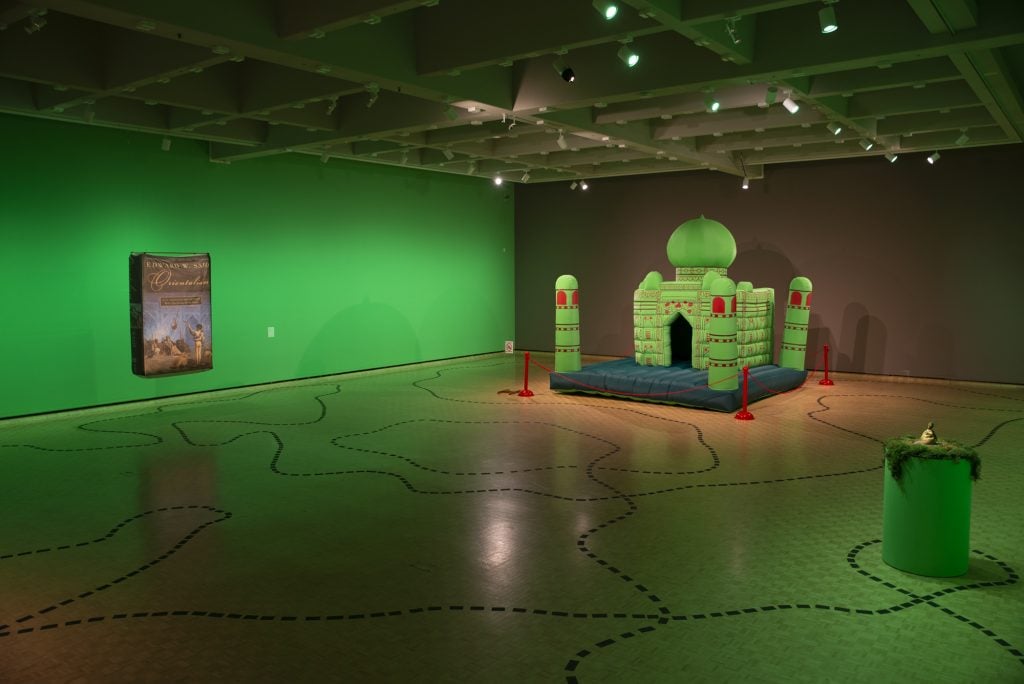
Installation view of Divya Mehra’s “From India to Canada and Back to India (There is nothing I can possess which you cannot take away),” (2020) at MacKenzie Art Gallery. Photo: Sarah Fuller. Image Courtesy the artist and Georgia Scherman Projects.
You’re the first Indigenous leader of a major gallery in Canada—the MacKenzie Art Gallery. How does that feel?
I’m incredibly proud and honored to take on this role and I am grateful to be welcomed as a guest in this territory; the Chickasaw homeland is in the South Eastern United States, and my Reservation is in Oklahoma. That medicine line—or border—between the United States and Canada is a colonial construct, but when I think about Indigenous leadership of our cultural institutions, I’m still dreaming of Indigenous folx guiding the vision of the galleries and museums in our own territories.
You grew up for a time in Regina, home of the MacKenzie Art Gallery, though your career and studies took you elsewhere before you ended up back there for this position. Did you feel, back then, a need to speak and act on cultural issues unique to Indigenous life?
Back then, I wasn’t quite as comfortable in my own identity. I was still going to Pow Wow and learning from my local Elders, but I was also really invested in Western education and kept these worlds relatively separated. We are survivors of cultural genocide, and so a lot of us have complicated relationships with our identities which can manifest in many ways. For people like myself—who grew up displaced from our territory, and who also have been afforded certain privileges through mixed-white and Indigenous ancestry—that can look similar to survivor’s guilt, like you shouldn’t have been the Chickasaw that survived, that you aren’t good enough to represent your ancestors, or like your exposure to Western culture lessens your belonging to your own culture.
Early in my curatorial career, I didn’t have a strong understanding of my own place in the world and in relation to my own nation and the territory I lived in. I worked with Indigenous artists and perspectives to talk about other issues, but I really needed time to make enough progress on my own journey before I was ready to publicly tackle cultural issues unique to Indigenous life.
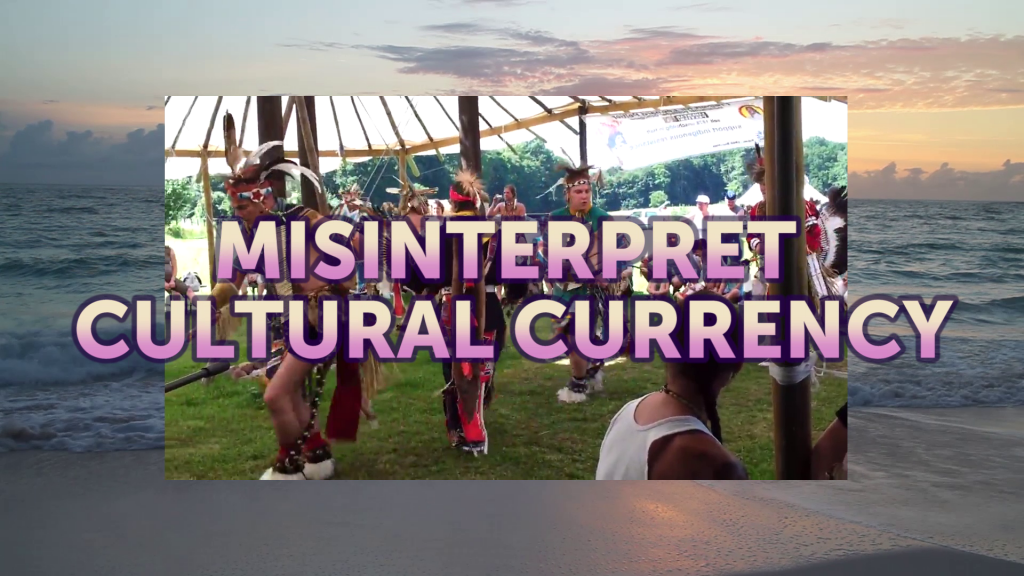
John G. Hampton’s own video work Footsteps (2016). Courtesy the artist.
And as you’ve gotten older?
I’ve since gotten a better handle on that discomfort. The toxic version of it can push you away from your culture towards colonial assimilation, but I’ve come to value a healthy, measured version, as a simple reminder that my lived experience is not representative of all Indigenous folx.
I feel it’s important to hold onto some of that discomfort, especially at times like this recent appointment, to recognize that the people who are in a position to speak on behalf of other Indigenous folx often have more proximity to whiteness (whether that’s skin colour, economics, speech patterns, or types of education) than those who have been more thoroughly excluded—that is a feature of a society structured around white supremacy. That does not mean fair skinned folx are less Indigenous than brown NDNs with rez accents, but it is certainly a different experience—one that is overrepresented in art and academia.
That type of overrepresentation is leaps and bounds above just white people having dominant control over Indigenous representation, but it can’t be left unquestioned and those of us who have the opportunity to help change those conditions have the moral responsibility to do so.
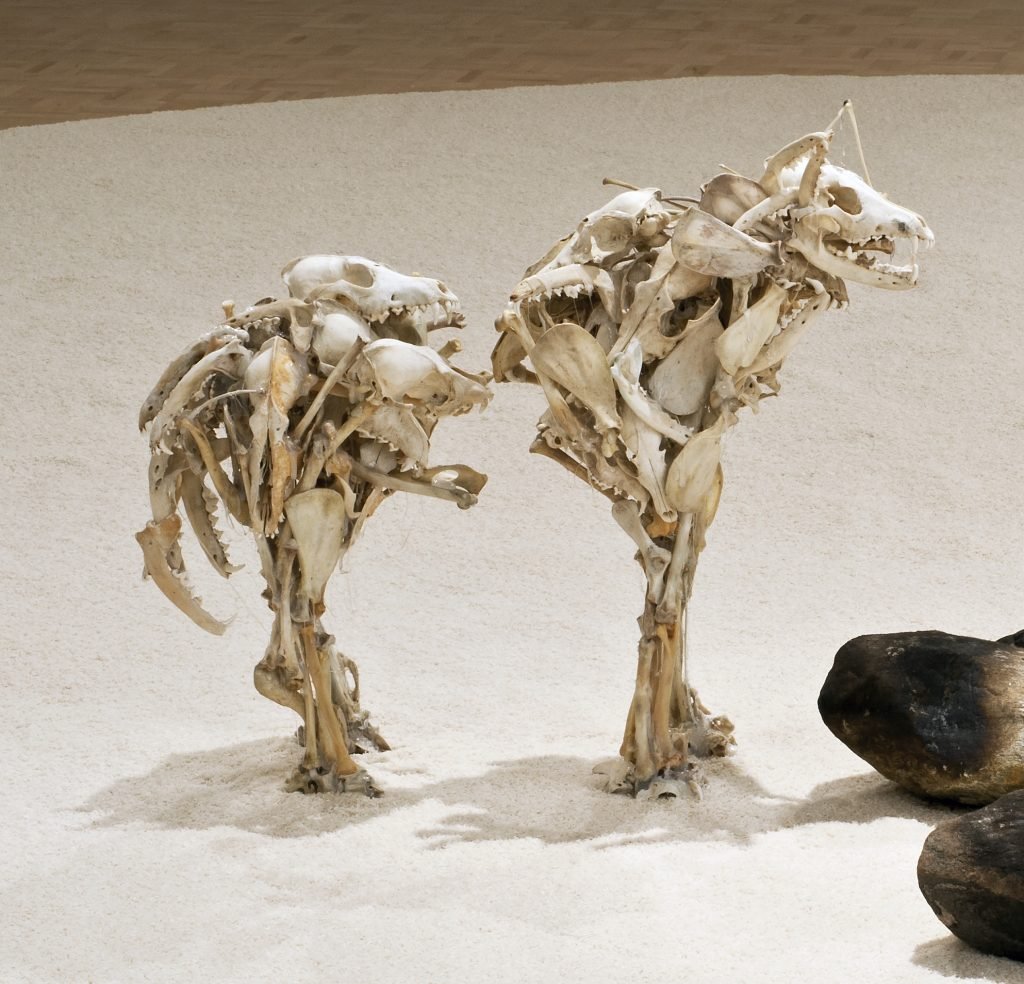
Edward Poitras Sirius takes a bite (2012). MacKenzie Art Gallery, University of Regina Collection. Photo: Don Hall, courtesy of the MacKenzie Art Gallery.
The MacKenzie Art Gallery has some very innovative new job posts, including an Equity Task Force and an Elder-in-Residence. How do these roles function?
The Elder-in-Residence position started from a personal need. I started my first curatorial appointment at Neutral Ground Artist Run Centre, also in Regina, by visiting Elder Betty McKenna to talk to her about what it means to curate from an Indigenous perspective—and specifically from her own Anishinaabe perspective. I’ve asked similar guidance from others throughout my career and still do in this new role. Elder Betty has had a long relationship with the MacKenzie as well—travelling to teach birch bark biting, sitting on our Indigenous Advisory circle, providing training to staff—so I asked her to assist in a more official and ongoing manner and requested to pay her like we would anyone else offering their professional expertise to the gallery.
The Equity Task Force started last spring when institutions were publishing black squares in solidarity with Black Lives Matters—we wanted to define what actions we were going to take to make a difference within our sphere of influence. So former CEO Anthony Kiendl and I decided to strike this task force with the aim of addressing racial inequity with the same urgency as we had with COVID-19. The scope of the task force has expanded since then, but the core tenant is about how we can create change within our organization so we can better project positive values as cultural workers in our broader communities.
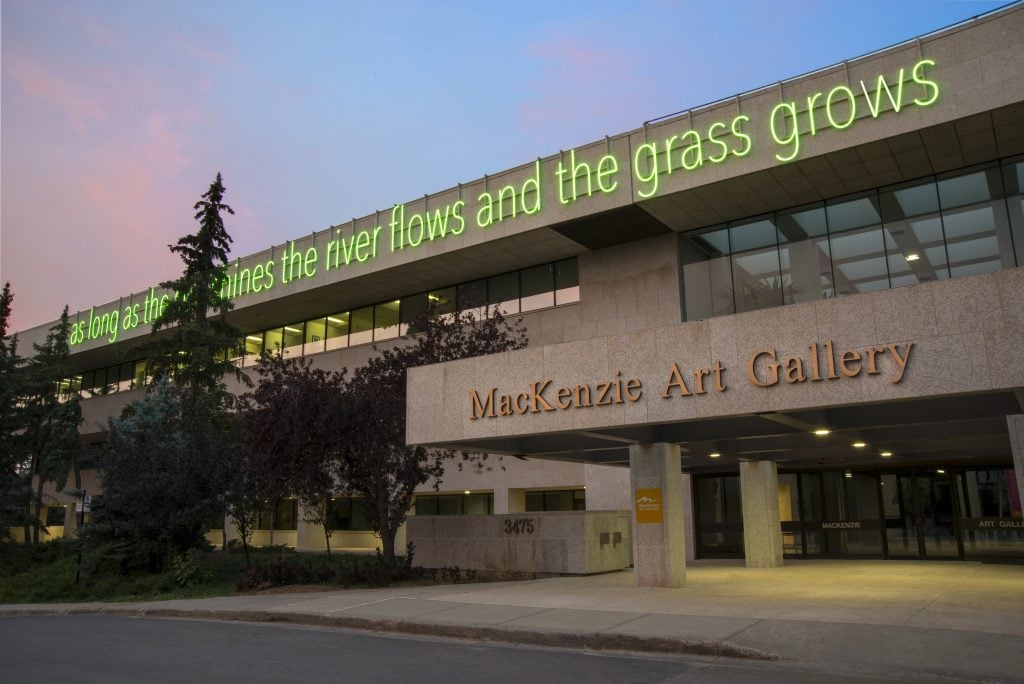
Duane Linklater Kâkikê / Forever (2018) on exterior of MacKenzie Art Gallery. Photo: Don Hall. Courtesy Mackenzie Art Gallery.
In Canada, there is a robust public funding model for the arts. But the Canadian art market remains nascent. What are the strengths and weaknesses of a publicly funded art model?
I’m incredibly supportive of the public funding model for the arts here in Canada. Both the US and Canada fund the arts through public funding bodies as well as tax incentives to private or corporate donors, but with different emphasis. The US model prioritizes tax incentives and the development of commercial markets where collectors are the primary source of income for artists. As a consequence, collectors have an outsized influence on the direction of the American art scene, and this creates conditions for a stronger art market.
The Canadian system has a greater priority on public funding—a philosophy that was partially influenced by a fear of American hegemony and the need to develop uniquely Canadian voices. With this emphasis on peer-review, other artists or arts professionals have a greater influence of the direction of the Canadian scene, and this results in less market-driven work as well as a weaker art market. I think both systems drive innovation in different ways, but I am quite partial to the Canadian model, particularly with how it can respond to questions of equity, how it can more effectively put artists’ voices at the forefront, and how it supports conceptual and alternative practices.
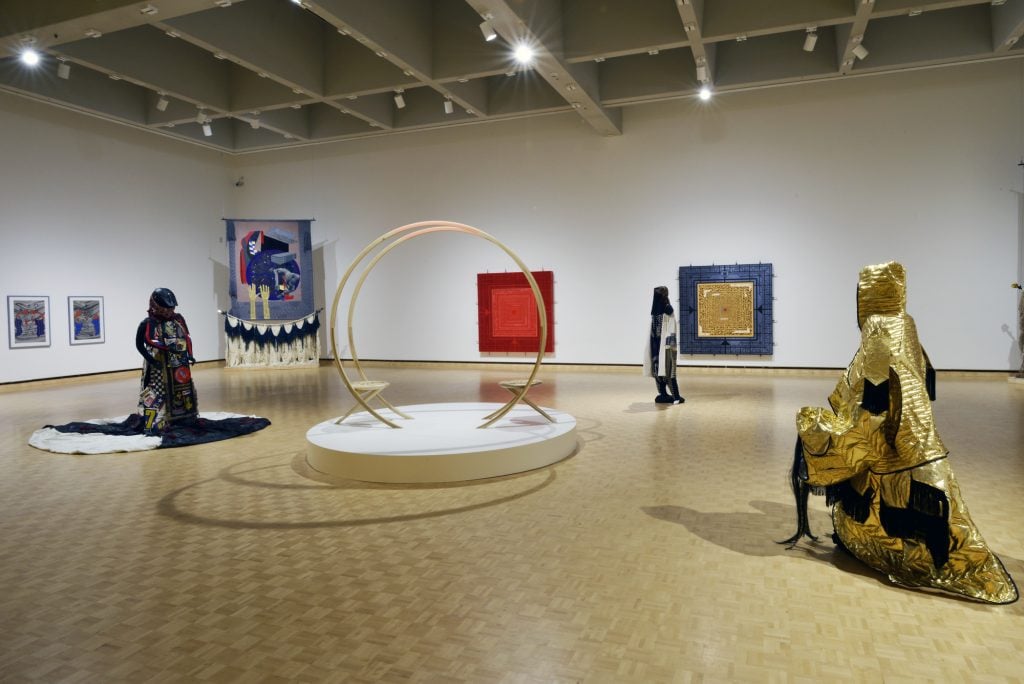
Installation view of Rajni Perera and Nep Sidhu’s “Banners for New Empires” at MacKenzie Art Gallery, 2019. Photo: Don Hall.
The museum recently made headlines when it restituted a looted work of Indian art that artist Divya Mehra discovered while making her exhibition. How do you feel about current debates on reparations?
I think repatriation is essential for museums to move forward into their next chapter. Without corrective actions, we can’t evolve beyond our legacy as monuments to colonialism. Canadian collections have a very different circumstances than British or American institutions, the majority of our stolen objects (and bodies) come from nations that are Indigenous to the territory Canada currently occupies. These are very recent histories of looting on massive scales—one of the most notable being sacred objects stolen during the potlatch ban of 1885 to 1951—most major museum collections hold objects from this dark chapter of human history.
In 1980, the U’mista Cultural Center in Alert Bay, on the West Coast of Canada, opened, an entire building dedicated to objects from just one potlatch raid, and they don’t even have all that was stolen. The repatriation department at the Royal BC Museum has done really amazing work, and hearing recent reports of a toxic and racist work environment really breaks my heart and also gives me even more respect for their repatriation team for the work they were able to accomplish under such circumstances, but it’s also a reminder the healing work that repatriation is supposed to be a part of can’t happen in isolation, it needs to be coupled with internal work as well.
Last fall, as part of the work Divya Mehra did for her exhibition “From India to Canada and back to India (There is nothing I can possess which you cannot take away)” an idol stolen at the direction of our gallery’s namesake, Norman MacKenzie, was repatriated to India. It was the first repatriation of an object in our care. We purchased a new work by Mehra to take its place, a leather bag with the same weight as the idol it was replacing. Divya’s work will rest where the idol once did, marking its history and this turning point in our collection when we started the process of living up to new standards for healthy relationships with our communities.
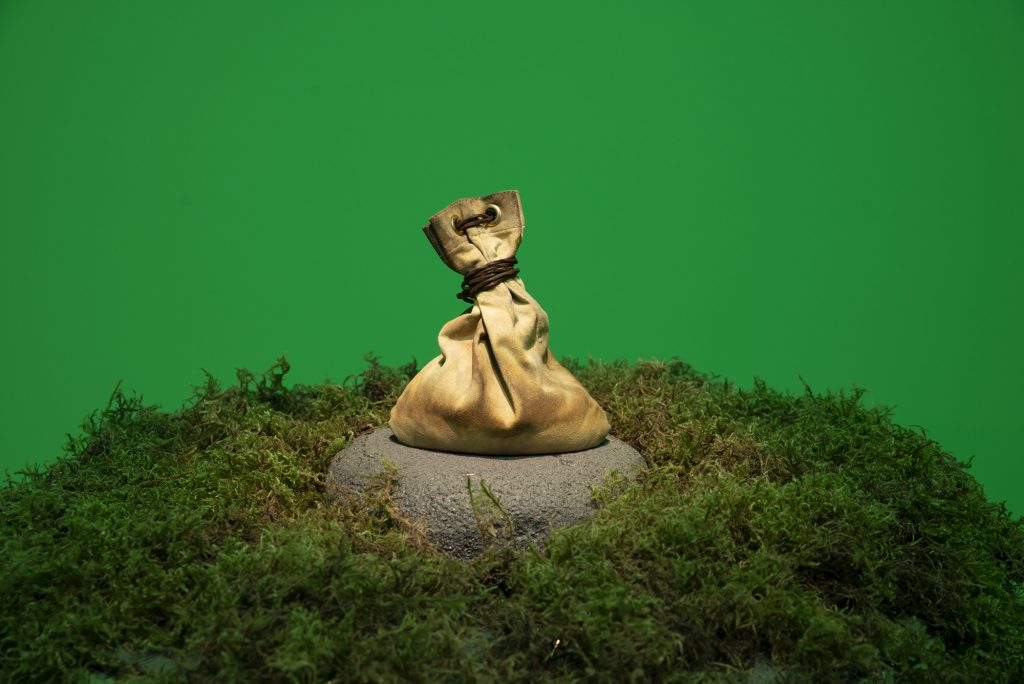
Divya Mehra, There is nothing you can possess which I cannot take away (Not Vishnu: New ways of Darsána) (2020). Photo: Sarah Fuller. Image courtesy the artist and Georgia Scherman Projects.
An upcoming project at the MacKenzie, “Conceptions of White,” is an exhibition and research platform that argues that there is no white race, but instead white power, which needs to be undone. How did this project come about?
The decision to release came from a desire to make our research a more active part of our community’s dialogs rather than our default mode of keeping it private until it is finalized as an exhibition. The nature of the project, and the moment we were—and are—in, called for a more prolonged public engagement, to start these necessary dialogs as early as we can, to articulate Whiteness and how it influences our institutions. I don’t believe we can decolonize or move forward to a healthier cultural reality if we don’t examine the dominant structures our institutions were created within and have worked to promote.
Bringing new dialogs into institutions without addressing how they are currently oriented, will ultimately veer towards assimilation. To genuinely make room for new perspectives, white supremacy has to be undone, and to do that you have to be able to see it and talk about it. We have gotten some push back around the phrasing of “dismantling white supremacy,” but the way I’m using here isn’t talking about white supremacist terrorist organizations, but about the more subtle and invisible ways that whiteness affords privilege within our institutions. Dismantling that does not mean there is no place for white voices, but that they should not have systemic advantage or dominance over others.
This touches on another point. At what point can art —should art—intervene?
I subscribe to the belief that museums are not neutral; neutrality sustains the status quo and perpetuates established power and inequity. I think that art needs to engage in the urgent and difficult dialogs that face us today, and that it helps us process concepts that we can’t comprehend or speak about in other ways.
Culture is the space where we debate and come to shared understandings of who we are as a people, it is the fabric through which we bind ourselves together as a society, so whether you intend to or not, art institutions are intervening— it’s a question of how intentional you want to be with it.